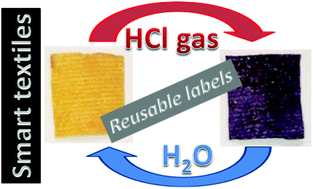Aromatic polyamides and acrylic polymers as solid sensory materials and smart coated fibres for high acidity colorimetric sensing†
Abstract
Reusable colorimetric acid responsive coated fibres and manageable films or membranes have been successfully designed and prepared herein. The design of the materials rely on the preparation of condensation and addition monomers both having the azobenzene group, which is used as a dye moiety and as a weak basic motif, and a N,N-dimethylamino moiety. The N,N-dimethylamino moiety is also used as a weak, albeit stronger, basic group as well as an electron donor or electron withdrawal group, depending on its protonation state. For the sake of applicability, the coated fibres were cotton commodity fabrics, and high-tech aromatic polyamide yarns and fabrics. The high-performance aromatic polyamides and the versatile acrylic structures, along with the pendant weak basic groups, with pKas in water ranging from 1.78 to −0.5 and in air from −1.5 to −3.9, provide the materials with a colorimetric sensing capability over a wide acidity sensing window. This sensing window ranges from 1 × 10−2 to 3 M for perchloric acid in water and from 4 × 10−7 to 9 × 10−2 atm for vapour pressure of hydrogen chloride in air. The colour change of the sensory materials from yellow/blank to red or purple, which occurs upon contact with acidic media, was easily identified using the naked eye. Washing these materials with pure water recovered their original colour and permitted their reuse.



 Please wait while we load your content...
Please wait while we load your content...